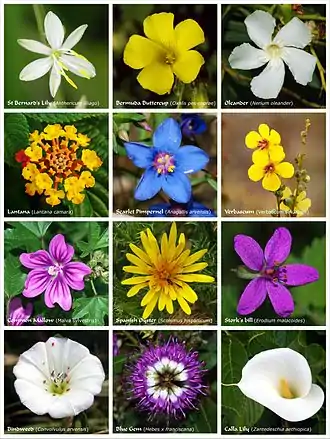Petrosaviaceae
Petrosaviaceae is a family of flowering plants belonging to a monotypic order, Petrosaviales. Petrosaviales are monocots, and are grouped within the lilioid monocots. Petrosaviales are a very small order (one family, two genera and four species were accepted in 2016[2]) of photosynthetic (Japonolirion) and rare leafless achlorophyllous, mycoheterotrophic plants (Petrosavia) found in dark montane rainforests in Japan, China, Southeast Asia and Borneo. They are characterised by having bracteate racemes, pedicellate flowers, six persistent tepals, septal nectaries, three almost distinct carpels, simultaneous microsporogenesis, monosulcate pollen, and follicular fruit.[3]
| Petrosaviaceae | |
|---|---|
_(20407475671).jpg.webp) | |
| Petrosavia sakuraii | |
| Scientific classification | |
| Kingdom: | Plantae |
| Clade: | Tracheophytes |
| Clade: | Angiosperms |
| Clade: | Monocots |
| Order: | Petrosaviales Takht. |
| Family: | Petrosaviaceae Hutch.[1] |
| Type species | |
| Petrosavia stellaris | |
| Genera | |
Taxonomy
The family has only been recognized in modern classifications, previously the plants involved were usually treated as belonging to the family Liliaceae. The APG II system recognized the family and assigned it to the clade monocots, unplaced as to order. The APG III system of 2009 and the APG IV system of 2016 placed family Petrosaviaceae in order Petrosaviales.[1][4]
Genera
As of June 2016, two genera are accepted by the World Checklist of Selected Plant Families:[5]
- Japonolirion Nakai, with one species
- Petrosavia Becc, with three species
Distribution and habitat
The plants in both genera are found in high-elevation habitats.
References
- Angiosperm Phylogeny Group (2009). "An update of the Angiosperm Phylogeny Group classification for the orders and families of flowering plants: APG III". Botanical Journal of the Linnean Society. 161 (2): 105–121. doi:10.1111/j.1095-8339.2009.00996.x. Archived from the original (PDF) on 2017-05-25. Retrieved 2013-06-26.
- Christenhusz, M. J. M. & Byng, J. W. (2016). "The number of known plants species in the world and its annual increase". Phytotaxa. 261 (3): 201–217. doi:10.11646/phytotaxa.261.3.1.
- Cameron, Chase & Rudall 2003
- Angiosperm Phylogeny Group (2016). "An update of the Angiosperm Phylogeny Group classification for the orders and families of flowering plants: APG IV". Botanical Journal of the Linnean Society. 181 (1): 1–20. doi:10.1111/boj.12385. ISSN 0024-4074.CS1 maint: uses authors parameter (link)
- "Search for Petrosaviaceae". World Checklist of Selected Plant Families. Royal Botanic Gardens, Kew. Retrieved 2016-06-12.
Bibliography
- Cameron, Kenneth M.; Chase, Mark W.; Rudall, Paula J. (July 2003), "Recircumscription of the monocotyledonous family Petrosaviaceae to include Japonolirion", Brittonia, 55 (3): 214–225, doi:10.1663/0007-196X(2003)055[0214:ROTMFP]2.0.CO;2, JSTOR 3218442
External links
| Wikimedia Commons has media related to Petrosaviaceae. |
| Wikispecies has information related to Petrosaviaceae. |
